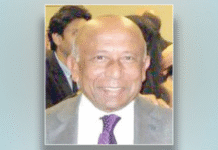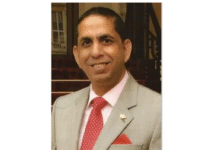
Mid April, 1971. A lanky young boy sneaked out of his family home in old Dhaka into the hitherto unknown world of warfare. A mate in the vicinity did the same. The political mood was already charged since Bangabandhu’s inspiring call of March 7, but the horrors of March 25 turned our world upside down. The despair, however, quickly turned to resolve with the thrilling call of resistance. Not much persuasion was needed. The intent to resist the Pakistani brutes, the pull of adventure, and the scope to escape parental control blended with the adrenaline call of the wild. But the two friends could little imagine they were on a life altering journey. Youth’s passion works in so many mysterious ways.
Half a century later, when I, one of the boys, now an elderly citizen, retrace that fateful plunge—the myriad recollections wrapped in blood, tears, toil, joy, grief, valour, folly, and fear rush down memory lane—it is difficult to set them apart. They sometimes make me wonder, were the sacrifices worth it? While instinct responds in the affirmative, reason gets a bit fuzzy. Wading in the five decades of turmoil, violence, uncertainty, achievements, and failures, it’s time to inquire what our goals were and how far we could attain them. Seeking equality, human dignity and social justice is enshrined in the constitution, but these political goals do not explain the philosophical foundations of creating a state. Did we have any? Fifty years is not a very long time in a nation’s history, but enough to make an evaluation for charting our future course. This train of thought leads me to taking a cursory look into our nationality, the raison d’etre for waging our Liberation War.
Pakistan deprived us both politically and economically, but what angered us most was it wanted to erase our ethnic Bengal identity, which forms the basis of a nation. A nation may have other elements in its body politic but without shared ethnicity, it’s incomplete. As family is the basic unit of society, ethnicity is the first unit of nationality. A nation can be artificially imagined like many postcolonial ones, but an ethnic people/society is an organic growth and can’t be imagined, bestowed or imposed. It may have other traits but racial similarity, shared geography, dialect, and sociocultural behaviour make them distinct. With these basic features, an ethnic people at some point in their evolution may grow into a nation. With the twists and turns of history, it may also grow into a political nation if its cultural and political aspirations match with material abilities. But this process may not inevitably lead to statehood; that depends on a host of conditions. In view of this general theory, how did the Bengalis evolve into a nation?
Various ethnic peoples evolved across the world at different times in history. They would have had little impact without power. Power is derived from multiple sources, like material wealth or wisdom/knowledge. On the positive side, it empowers a people, lifts aspirations, refines culture, and gives a sense of unity and purpose. Several ethnic nations, including Bengal, evolved in different parts of the subcontinent over the past thousand years. It also became part of a few millennia old centre-region conflict. For resisting the centre’s imperial reach, the regions developed their own ethno-regional, racial and cultural patterns. In Tagore’s view, “nation” carries three different meanings. First, it means jati—a caste or subcaste in Hinduism, both in professional and social categories. Second, jati also means race or sub-races like the Bengali, Gujarati, Marathi, Tamil, Assamese, Punjabi, Rajput and so on. These jatis evolved as a result of a mixture of races from outside India and local Austric and Negroid people over a long period of time, and by late middle-ages they evolved as clearly visible ethnic nations.
Third, jati also means nation. An ethnic nation can grow into a political nation, like several in Europe. Bengal experienced such a transformation from the mid 19th century. Of course, this didn’t happen suddenly. From the early middle-ages, the assertive Pathan Sultans of Bengal had advanced the Bangla language to counter the influence of imperial Delhi. The second influence was the birth of syncretism, a blend of the Sufi, Vaishnava and Buddhist spiritual traditions. Third, the Hindu and Muslim large landlords had joined hands, however briefly, against the Mughal invasion, like their counterparts in the Deccan, Maharashtra and Punjab. It was primarily to save their estates, but it also sowed ethnic unity. All these contributed to the growth of an ethnic nation, but it was the colonial assault and tyranny that finally created the fertile ground for Bengal to awaken and assert itself. In the meantime, a new generation of educated middle class emerged, unwilling to remain adjunct to the colonial masters. The Bengal renaissance was their collective expression to rediscover themselves.
Since the Bengali Muslims were at least two generations behind the Hindus in acquiring modern education, it was only from the 1920s that the renaissance dawned upon them. Of course, earlier, a number of notable literary figures had pioneered this awakening, but it was from this period that a sizeable and certainly secular Muslim intelligentsia grew in society. Several literary circles led by Nazrul and other creative individuals made key contributions in discovering their Bengali heritage. As they were skeptical of orthodox Islamic views, they connected with the rich attributes of the Bengal renaissance, free of communal tilts. It was a quest for the educated Bengali Muslims to graduate from an ethnic to a political nation. Of course, it still had to wait.
The nascent Bengali nation—the fruit of the renaissance—got divided in the communally frenzied days of pre-Partition India. The Hindus in the west yielded to the imagined Indian nation, which in fact was a multinational state, while the Muslims in the east submitted to another imagined nation of Pakistan, fearing the tyranny of the Hindu loan sharks/landlords. While the west stayed put within the Indian state, East Bengal, having made common cause with its co-religionists, soon reclaimed its ethnic identity. Facing economic, racial and cultural bias from the Pakistani rulers, the Bengalis demonstrated passion for their language, which slowly grew into a national movement and culminated in the creation of Bangladesh; a sovereign nation state. Bengalis rose to the occasion and took a quantum leap to be free from the shackles of medieval moorings. For the first time in the subcontinent, out of several similar ethno-regional nations, Bengalis, like the English, French or the Chinese, organically transformed into a political nation over centuries and created a state. Of course, this does not preclude other minor nationalities sharing the same geography.
Liberation was a great feat! But having created a state, we got busy in the ensuing decades, tearing ourselves apart trying to decide whether we are Muslims or Bengalis. Why this confusion? Are they mutually exclusive? Not at all, if their roles are clearly defined. Eons ago, faith was the primary identity of all humans. State and religion was inseparable. Consequently, over a long period both got corrupt, though at different stages of different faiths. In the modern age, state and religion was parted with clearly defined roles. State would take care of temporal affairs of society based on human reason, while religion will deal in the spiritual domain. As for Bangladesh, after Liberation, we found ourselves surrounded by India; we needed friends beyond. As a Muslim majority state, we joined the OIC in 1974, though we were already a secular state. Moreover, all its members were dead against the Liberation War. Then in 1977, we erased secularism from the constitution and finally hit the last nail in the coffin in 1988 by making Islam the state religion.
Ever since, a regressive religiosity has slowly crept in at every level of society. How far is this consistent with the spirit of our Liberation War? Yes, there is an overwhelming Hindu-Muslim divide in the subcontinent; and being part of its geography, history and culture, its influence is inescapable. But the uniqueness of our ethnic nation’s transformation into political nationhood, free of historical bondages, ought to have made the difference. Unfortunately, it hasn’t, and we need to investigate why.
Back in 1946, we voted nearly en bloc for Pakistan. At that time, we were both Muslims as well as Bengalis. But soon, we realised unity based on faith was a myth and started to assert our Bengali ethnic identity. First, through the Language Movement and Jukto Front election, and then Awami League dropping “Muslim” from its name in a meeting held in 1955 created a secular awareness. Slowly, the cultural front took the lead, growing in leaps and bounds and culminating in the Six Point Movement. The combined impact of these interventions galvanised the Bengali nation into action.
It’s this growing secular Bengali national identity the Pakistanis hated most and deprived us for on all fronts. They expected Bengaliness to be subservient to the imagined nation of Islam embodied in the state of Pakistan. And that is why the Liberation War became a necessity for creating our own state. But if in free Bangladesh, we seek to reestablish the Bengali Muslim nation as state policy, the very philosophical basis for the war falls apart and creates ground for unwittingly relapsing into the two nation theory.
Although the secular state policy has been restored recently, the state religion is still there. Now we are both a secular and a religious state. How can we resolve this paradox? The usual reason is that 90 percent of the country are Muslims. Perhaps it also reflects the wider Islamic world’s still somewhat ambiguous position between the modern nation state and the mirage of Islamic Umma. This line of reasoning forgets Europe is also 90 percent Christian, but that doesn’t stop it from separating religion from state. The very rise of modernity was to avoid religious control in state affairs, which paved the way out of the middle ages. The result of dragging religion back into state affairs in modern times has not been positive anywhere.
In 1953, after a bloody clash between two groups of Islamic clerics in Lahore, two high court judges were entrusted with judicial inquiry. After lengthy investigation and cross examination of diverse clerics and multiple other relevant people over a year, Justices Munir and Kayani, wrote a long report with recommendations on separating religion from the state. However, ever since, all the successive Pakistani governments ignored it. As a result, innumerable radical Islamic groups, state sponsored or private, have grown to hold the state hostage. Afghanistan is another sorry example. Now, India is on an irreversible course of becoming a Hindu state by tossing its secular credentials to the gutters. It is not yet legally binding, but the ramifications are already grotesquely visible. All religious minorities are virtually at the mercy of Hindu supremacists.
Separating religion from state is not faithlessness. Islam is in our DNA. It has an important role to play in our personal, family and social lives, but not in state affairs. If it does attain such a role, the above mentioned fates will be inescapable—a brief attempt in that line, in the form of curbing women’s rights, was made in the recent past. State religion is not consistent with our secular credentials.
Ali Ahmed Ziauddin is a reacher and activist. Email: aliahmedziauddin@gmail.com









